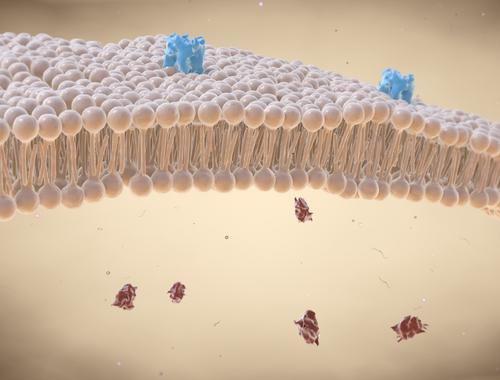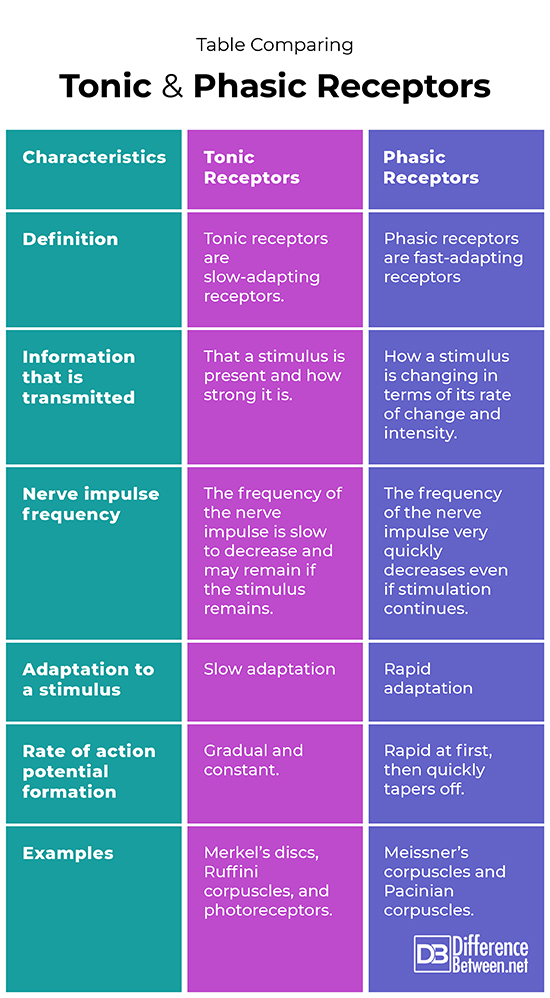Difference Between Tonic and Phasic Receptors
Tonic receptors are those that change slowly in response to stimulation and provide a constant frequency of nerve impulses. Phasic receptors change rapidly with stimulation and produce a diminishing frequency of nerve impulses.

What is a Tonic Receptor?
Definition:
A tonic receptor can be defined as a slow-response receptor that provides information on the strength of a stimulus.
Type of information:
A tonic receptor provides information to the nervous system that there is a stimulus, and it gives information about how strong the particular stimulus is.
Action potentials:
The nerve impulses (action potentials) of a tonic receptor occur gradually when stimulated. This means that the action potentials are generated continuously and at a fairly consistent rate for a sustained stimulus.
Examples of tonic receptors:
Merkel’s discs are an example of tonic receptors. These particular receptors respond to pressure and are found in the skin. They also help you to distinguish objects from one another by sensing changes in texture. Ruffini corpuscles are mechanoreceptors in the skin that detect when the skin is stretched and moved. They are also involved in fine motor movements of the fingers. Nociceptors, which detect pain, are also tonic receptors.
Examples of pathological conditions affecting tonic receptors:
Damaged nociceptors can result in a condition called hyperalgesia. This is when a person feels extreme sensitivity to pain. It can happen because of illnesses like rheumatoid arthritis or inflammation.

What is a Phasic Receptor?
Definition:
A phasic receptor is a fast-adapting receptor that provides information about how a stimulus changes, specifically its rate of change.
Type of information:
The type of information that a phasic receptor provides is about a change in the intensity of a particular stimulus.
Action potentials:
A phasic receptor very rapidly generates a nerve impulse in response to stimulation. The frequency of action potentials decreases in time while stimulation continues.
Examples of phasic receptors:
Pacinian corpuscles are phasic receptors that occur in the skin. These receptors respond to and allow us to sense vibrations through the skin. Meissner’s corpuscles are in the dermis, and they are involved in sensing the initial touch of objects. Thermoreceptors are initially phasic but do change to tonic if a stimulus continues.
Examples of pathological conditions affecting phasic receptors:
Diabetes that is poorly controlled can cause damage to phasic receptors in the body, especially in the feet. There is also a rare condition known as Pacinian corpuscle hyperplasia, in which corpuscles enlarge, producing nodules under the skin.
Difference between Tonic and Phasic Receptors?
Definition
Tonic receptors are slow-adapting receptors. Phasic receptors are fast-adapting receptors.
Information that is transmitted
Tonic receptors provide information that a stimulus is present, and it indicates how strong it is. Phasic receptors give information on how a stimulus changes, specifically, the rate of change of the stimulus.
Nerve impulse frequency
In the case of a tonic receptor, the frequency of the nerve impulse is slow to decrease and may remain if the stimulus remains. In the case of a phasic receptor, the frequency of the nerve impulse very rapidly decreases even if stimulation continues.
Adaptation to stimulus
Slow adaptation is a feature of a tonic receptor. Fast adaptation is a feature of a phasic receptor.
Rate of action potential formation
The rate of action potential formation with tonic receptors is gradual and constant. The rate of action potential formation with phasic receptors is initially fast but then decreases with stimulation.
Examples
Merkel’s discs, Ruffini corpuscles, and photoreceptors are all examples of tonic receptors. Meissner’s corpuscles and Pacinian corpuscles are all examples of phasic receptors.
Table comparing Tonic and Phasic Receptors

Summary of Tonic Vs. Phasic Receptors
- Tonic and phasic receptors are both found throughout the body, particularly in the skin.
- Tonic receptors provide a gradual and slow response to stimulation.
- Phasic receptors are fast-acting but have a tapering off of the impulse with more stimulation.
FAQ
What is the key difference between tonic and phasic receptors?
Tonic receptors are those that provide a graded response to a stimulus, while phasic receptors provide a rapid response that decreases in time.
Why are pain receptors tonic?
They are tonic because they continuously detect and send impulses in response to pain.
What is meant by a phasic receptor?
A phasic receptor provides a quick response to the stimulation, but it diminishes in time. In other words, fewer action potentials are propagated with further stimulation.
What does tonic receptor mean?
A tonic receptor is one where there is a slow, yet constant, response to stimulation that remains while the stimulus is present. The frequency of action potentials remains the same over time.
Which senses are tonic, and which are phasic?
The sensation of pressure on the skin and vision can be viewed as tonic because they involve tonic receptors, namely, mechanoreceptors and photoreceptors. Smell, touch, and temperature are phasic senses with corresponding phasic receptors.
What are the phasic receptors?
Phasic receptors are those that respond quickly to a stimulus.
What is an example of a tonic receptor?
An example of a tonic receptor is the nociceptor, which is a receptor that is triggered by painful stimuli.
What are tonic and phasic receptor organs?
Tonic receptor organs include the skin and muscles, which contain tonic receptors. The skin is also an organ that contains phasic receptors.
- Difference Between Rumination and Regurgitation - June 13, 2024
- Difference Between Pyelectasis and Hydronephrosis - June 4, 2024
- Difference Between Cellulitis and Erysipelas - June 1, 2024
Search DifferenceBetween.net :
Leave a Response
References :
[0]Binder, Marc D., Nobutaka Hirokawa, and Uwe Windhorst. "Adaptation of sensory receptors." Encyclopedia of Neuroscience. Springer, 2009. 54.
[1]Jammes, Y. "Tonic sensory pathways of the respiratory system." European Respiratory Journal 1.2 (1988): 176-183.
[2]Madrid, Rodolfo, et al. "Tonic and phasic receptor neurons in the vertebrate olfactory epithelium." Biophysical journal 84.6 (2003): 4167-4181.
